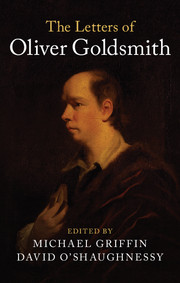30 - To William Hunter, [London, c. June 1770]
Published online by Cambridge University Press: 12 December 2024
Summary
Dr William Hunter (1718–83), physician, anatomist and male-midwife, was born in Lanarkshire in Scotland, educated at the University of Glasgow where he was taught by, among others, the moral philosopher Francis Hutcheson. Without graduating, Hunter was apprenticed to William Cullen in the latter's Hamilton medical practice. Hunter attended Alexander Monro's lectures on anatomy in 1739, after which point he emigrated to London in 1740 to study midwifery with William Smellie. In Paris in September 1743, Hunter attended the anatomy lectures of Antoine Ferrein, the recently appointed Professor of Medicine and Surgery with whom Goldsmith intended to study when he travelled to Paris in 1754 (see Letter 4 above). Hunter returned to London by the summer of 1744, where he regularly lectured for the rest of his life. In 1754, Hunter became a member of the Society of London Physicians. In 1761, he became midwife to Queen Charlotte for the birth of her son in August 1762, after which point he became physician extraordinary to the Queen, attending upon all her pregnancies. He was elected Professor of Anatomy at the Royal Academy of Arts upon its foundation by the King in December 1768. Hunter was a Whig in politics, and a friend to Horace Walpole, who viewed his association with the royal family with some scepticism. Polite and socially capable, Hunter was friendly also with Henry Fielding, Hester Thrale, David Hume and, it would seem from this correspondence, with Goldsmith. Goldsmith cites Hunter's writing on bones found near the River Ohio in America in his History of the Earth, and Animated Nature (1774).
In this letter, Goldsmith writes in support of his nephew William, son of Daniel Hodson and Goldsmith's sister Catherine. In the letter following, Goldsmith writes to Hodson – a rare familial letter by this point in his life – to report William's safe arrival in London. That letter to Hodson also provides the conjectural date for this one.
The copy-text is the manuscript in the Royal College of Surgeons in England. It was first published by Balderston in 1928.
Dear Sir,
The young gentleman who carries this is my nephew. He has been liberally bred and has read something of physic and surgery, but desires to take the shortest and best method of being made more perfect in those studies.
- Type
- Chapter
- Information
- The Letters of Oliver Goldsmith , pp. 83 - 84Publisher: Cambridge University PressPrint publication year: 2018

